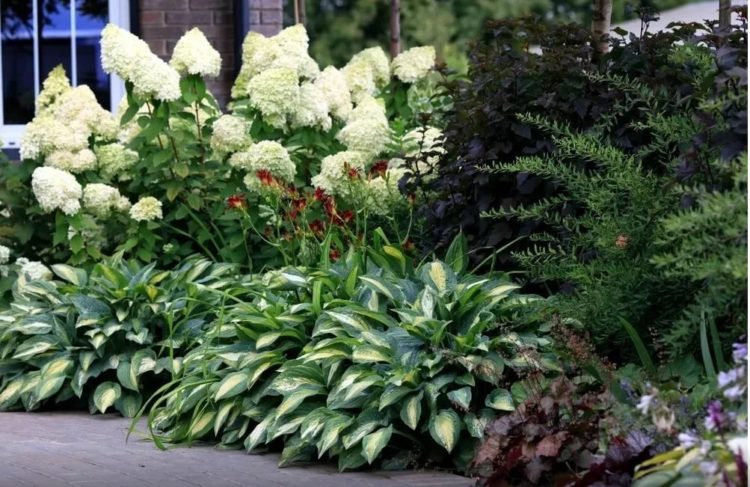If trees grow on your site, then there is a shadow under them. If there are deaf fences - darkened places are also formed under them; The northern wall of the house or any economic building also mainly obscures the territory.
Contents
But you really want beauty on the site! And, sitting in a shade, I want to admire the multi -color no less than in sunny areas. All these shaded places are great for landscaping. Only to plant trelly plants need to be planted here. There are flowers that cannot stand direct sunlight at all, others need partial shade or multiple light. That's about them and there will be a conversation.
Which flowers are better to plant in the shade: the list and description of trendy plants and flowers
Below is a list of plants and flowers that feel excellent in shaded areas. They will become an adornment of all corners of your summer cottage, a front garden or a house territory. The main thing is to take care of high -quality drainage and watering, since such plants need moisture. Which flowers are better to plant in the shade - the list and description of trendy plants and flowers.
Pansies
- This cute, simple and unpretentious, but such a flower beating in a combination, everyone knows under the name “pansies”, although it officially belongs to violets and is called the Viola tricolor. Flowers can be one- or two-year-olds, there are also species related to perennials. They bloom, depending on the variety, spring or summer, flowering time is also determined.
- The flower has rod root system, the length of a direct or branchy stem can reach 30 cm. The flower has five petals directly, of which two are larger than the rest. The unique overflows of shades reaching black, and bright spots closer to the center - all these are the distinctive features of the pansies that distinguish them from a number of ordinary violets.
- The most suitable place for planting pansies will be a place with a slight shading or the space located in partial shade. The more sunlight will fall on the bud, the larger the flower itself will be. But if you need prolonged flowering, it is better to plant a flower in a more shaded place.
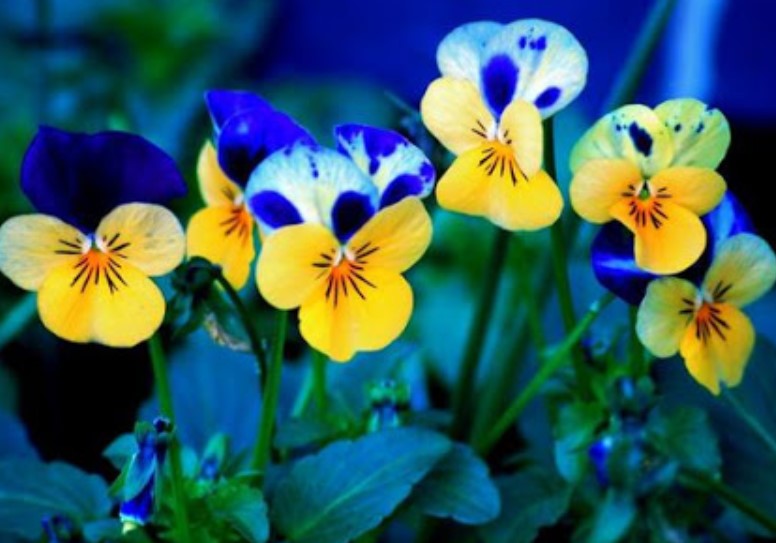
Astilba
- For this flower, the most suitable place is a small partial shade. Then, provided that the soil fertilized, fertile organic, Astilba will delight with her unusual panels until autumn, are planted. The leaves on the bushes belong to cirrus-dissected, in the spring there can be a copper shade.
- The height of the plant can approach a meter, and individual varieties - and to two, so it is better to plant it in the back of the flowerbed. Most often, Astilba is used in a border version or in mountaineering.
- Usually flowering time is the second half of summer. The flowers themselves have a different color: from snow -white to scarlet. Beautiful and leaves that have a glossy dark green tide. Since the century before last, when Astilba was brought to Europe, the plant became popular for shadow sections and gardens.
- Astilba leaves can be both simple and cirrus, painted in dark green (sometimes with a reddish tint) color. Flowers are small in size, openwork, combined into inflorescences of a rhombic, panicem or pyramidal shape. Color is most often found in red and white, from pure white to lilac-lilac shades. Blooms in the summer. In total, there are about 40 varieties of astilbe.
- When choosing a shaded area for planting this plant, you should pay attention to the presence of loamy soil and the availability of water (closely passing groundwater, pool or fountain). The neighborhood of Astilba with Hosty, which is also presented on our list, will be very successful.
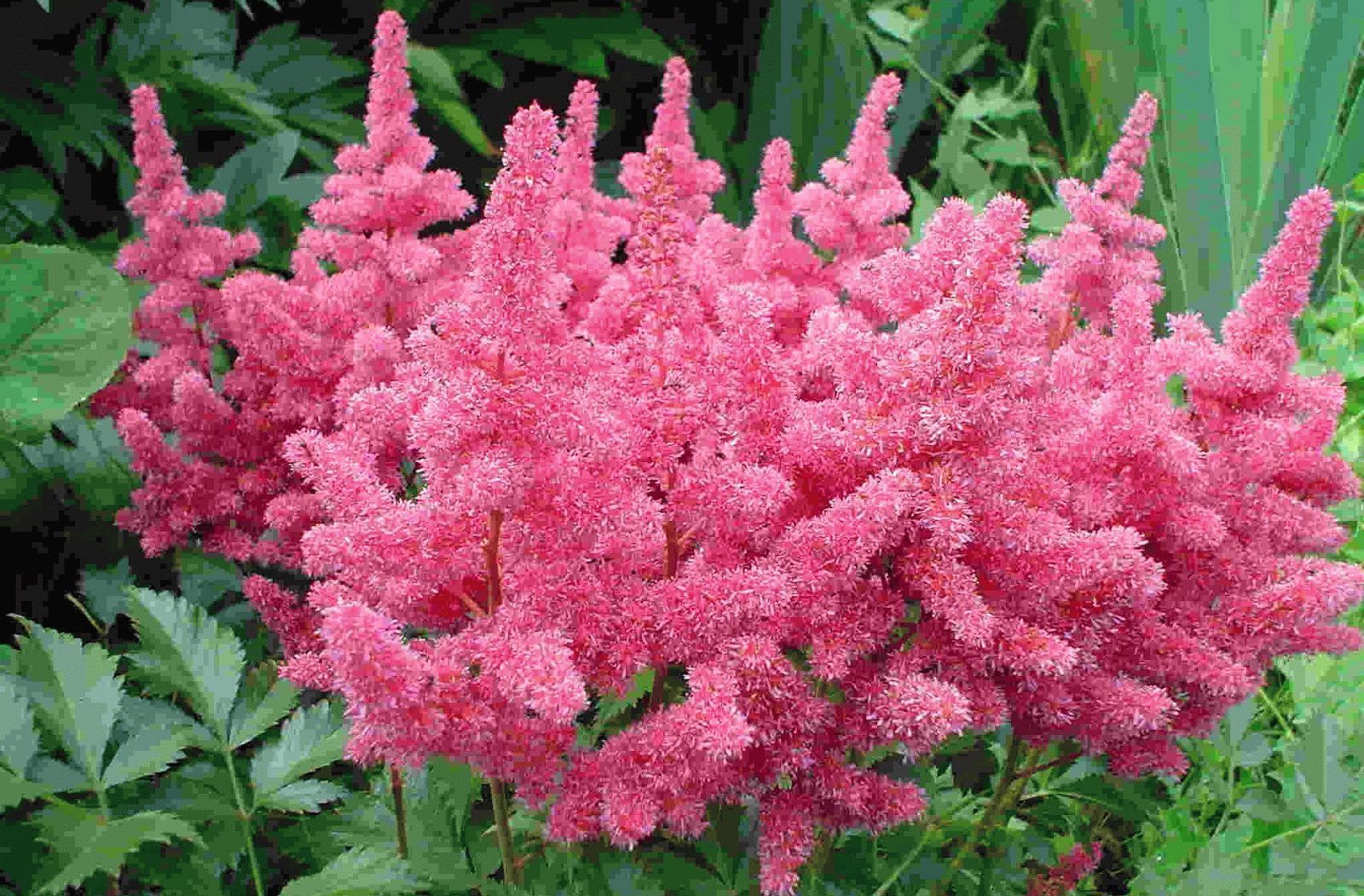
ASTASTION (star)
- Refers to the umbrella family, which are quite unpretentious. Their growth in shaded places is no less intense than in open sunny areas. The difference is that in the absence of sunlight, the color of the plant is less intense in splendor and brightness.
- As for the duration of flowering - it is exactly the same and is the whole summer season. Assaging blooms with small flowers resembling stars that are collected in the “constellations”-sustains. The plant also has large carved leaves, also performing a decorative function, and also throughout the summer.
- The height of the astra can reach a meter. On direct shoots are separate (or lobed) leaves collected in basal sockets. Inflorescences have a white or pink-brown color. Avalia refers to honey plants, is quite unpretentious with regard to irrigation and temperature regime. Popular on flower beds, for decoration of borders.
- Very often, the flowers of asstration are used in bouquets, since they retain freshness and “product” for a long time. The most common in our latitudes are the following types of aperture: large, largest, small, carnio, Bavarian, etc. will become good neighbors: astilba, geranium, Medunitsa and host.
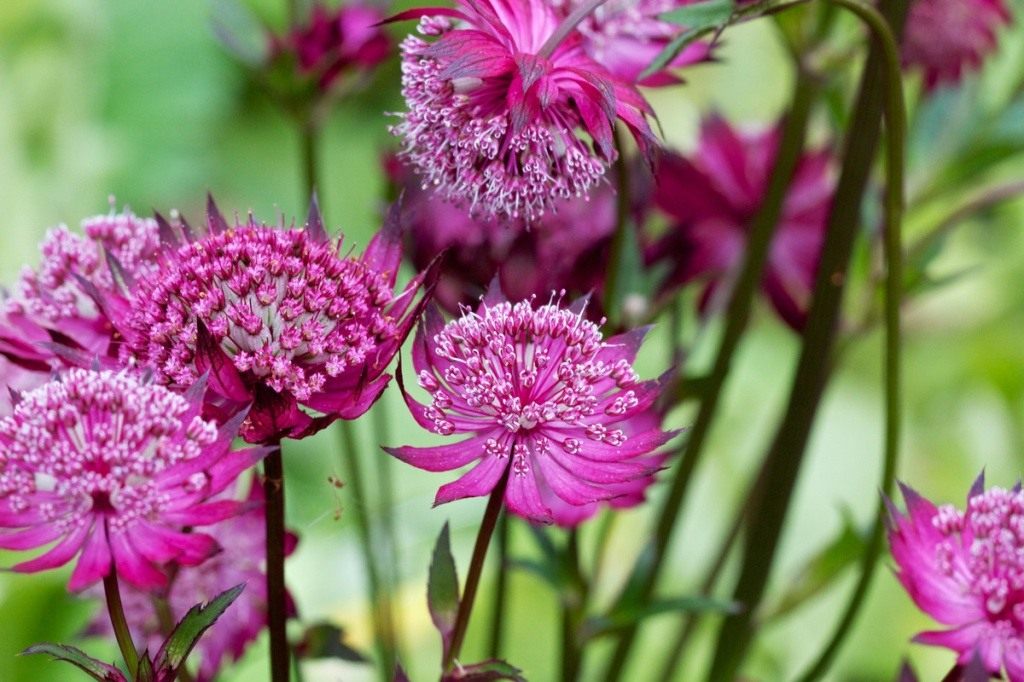
Balsam
- For this plant, multiple light is most suitable, and direct sunlight is destructive for it. Flowering begins in July and lasts until the first frosts. Today, dwarf varieties of Balzamine came to the fore. The plant has a thick fleshy stem that reaches 75 cm, is annual. It has gear leaves of an elliptic shape of light green color.
- It blooms from the beginning of summer to frost in large flowers (up to 5 cm in diameter), which resemble, depending on the variety, rose, cloves or camellia. It may be simple or terry. The color scheme is from white to lilac-red. Among popular varieties - novogvinean, Waller.
- This is a fairly unpretentious plant, preferring partial shade and wet loose soil. They are good for designing trunk circles or flower beds, and near low lamps, dwarf balsam looks especially impressive. They are beautifully combined with colors such as host, Kohlius, Begonia, Amaranth.
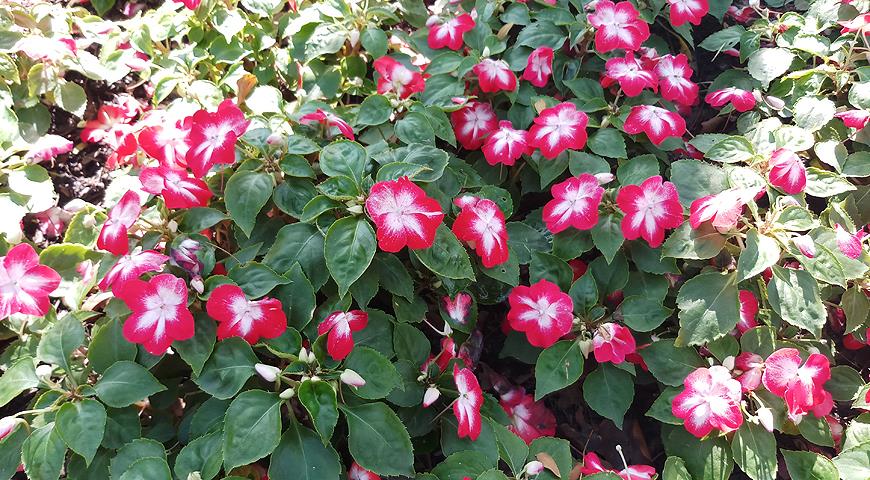
Barvinok
- Barvinok is characterized by a creeping stem, on which the leathery dark green leaves of a dense structure are quite densely located. Flowers -Large, which most often have a blue-blue color, but can also be purple, pink, white or purple.
- Abundant flowering - In the spring, in the summer the plant looks like a continuous green carpet on which single flowers are occasionally located. Refers to perennials, prefers a moderate climate. It can grow with spreading bushes, reaching a height of 35 cm. The barvinka flower reaches 3 cm in diameter, has 5 bent petals divided along the edges, and stamens and pestle are visible in the center.
- Among the most common species of Barvinka: large, small, pink. It grows well in a not very thick shadow of deciduous trees on loose soils, not very sensitive to drought. The only minus of this plant is that it is able to “displace” neighboring flowers, so periodically, barvino must be pruned.
- Often the flower is planted for masking naked ground under trees, masonry. If the flower garden involves several plants, barvins are usually located ahead due to its lowness. It looks good in climber or rockery, as well as along the borders. A beautiful combination with colors such as medunitsa, forget -me -nots, primrose, strait.
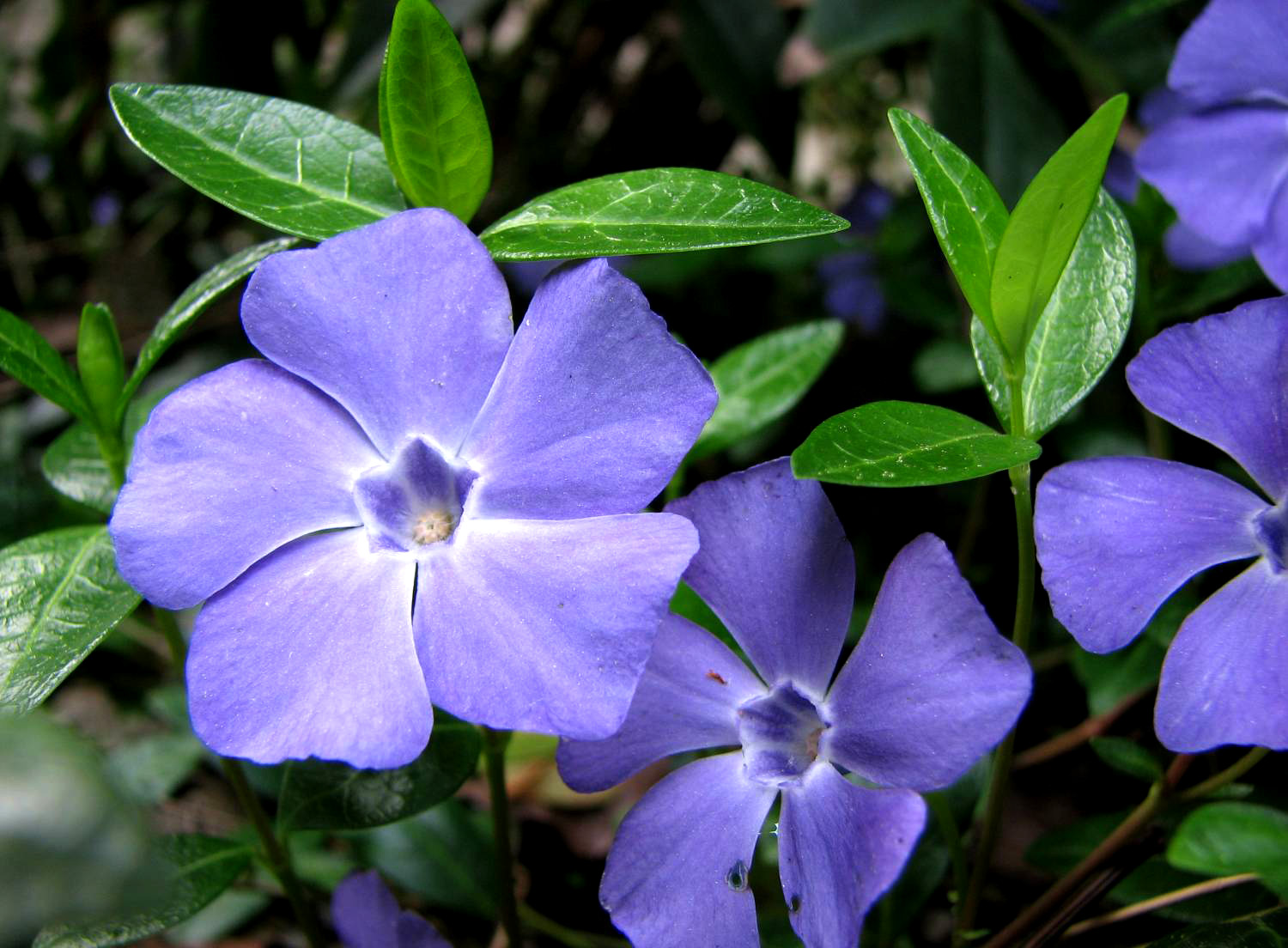
Begonia
- The plant is very suitable for planting in partial shade is a begonia. Her fleshy rounded leaves can be painted from light green shades to dark, chocolate-brown. The color scheme of the flowers themselves, reminiscent of tiny roses, is diverse - starting with white and ending almost black.
- The size of the buds also varies: from small, about 2 cm, to large, reaching 15 cm. The planting of begonia is carried out closer to the end of June, and flowering lasts until September. The plant is quite resistant to coolness, but not adapted to frost.
- Begonia is essentially a compact bush, reaching an average of up to 20 cm, so excellent for group plantings decorating flower beds, balconies or street flowerpots. For planting in open ground, tuber varieties (up to 30 cm high, with terry or simple petals) are suitable; Pendula, having an ampel shape and resembling a bulk bush with small flowers; Low Eternally flowering begonia, which, as a rule, has small flowers of pink-red shades.
- The best place for planting is partial shade, in addition, it should be the possibility of constant moisture of the Earth. The most preferable will be the landing in combination with other colors in the shade, which will “cover” begonia from negative influences.
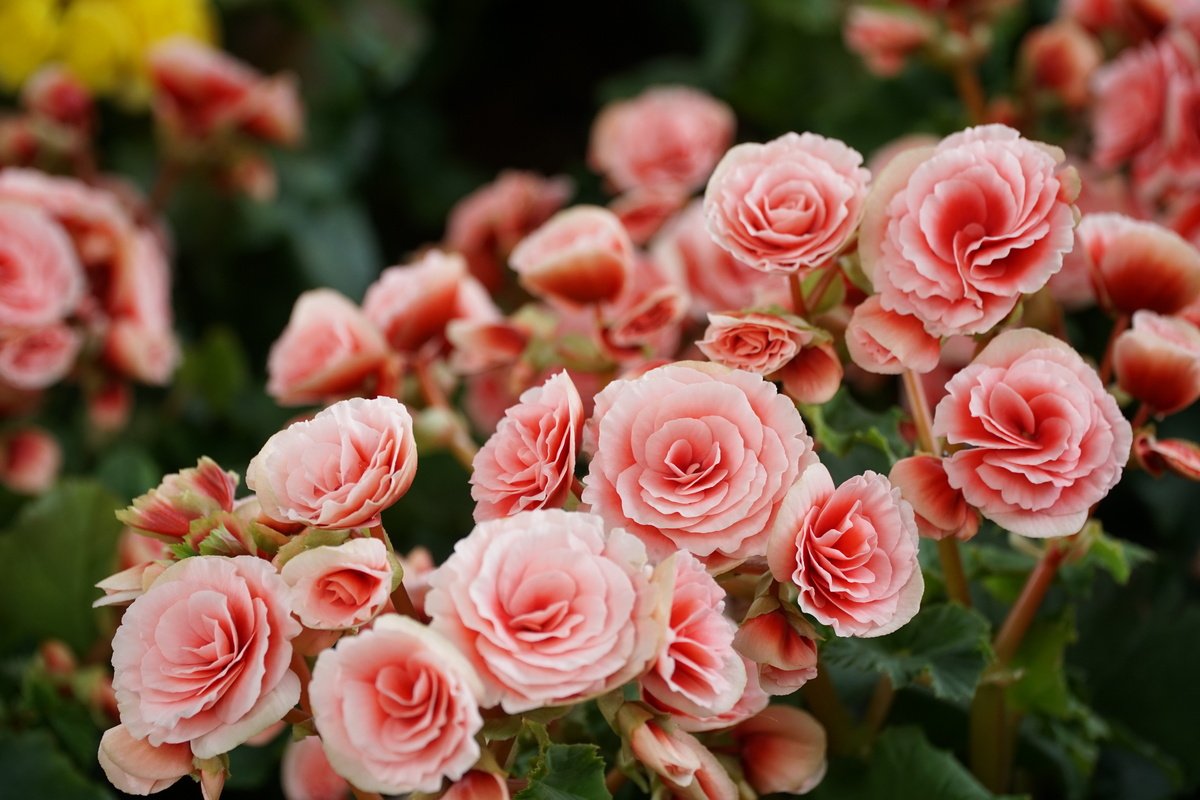
Brunner (forget -me -not)
- Brunner’s perennial begins to bloom in May, and closer to the fall begins the second flowering of beautiful frosty frost-silver leaves, so the plant is especially popular.
- Small flowers of heavenly color, reminiscent of forget -me -not, bring a note of freshness to the landscape, and at the same time grow perfectly under the shadow of tall trees.
- In partial shade, on the wet fertile soil of Brunner, almost six months, from April to autumn frosts, will be a decoration of the site.

Water bribe (aquilegia)
- The flowers of the water column are blue or white, usually with short spurs. Recently, terry varieties that have long spurs and a variety of color scheme have appeared, as well as dwarf varieties specifically for climber.
- The seats blooms at the very beginning of the summer season, starting in May, about a month, and separately each flower is about a week. The flower loves a shadow in which it blooms longer than in the sun, and moisture. Refers to perennials of the Lyutikov family And presented more than a hundred species.
- The flower and stem of the water collection are connected using "spurs", the leaves-twice-three times triple, having a bluish plaque. Their surface has water-repellent properties, the dimensions reach 5 cm in length and about 3-in width. The bud is similar to the funnel and consists of five separated petals. As the plants grow on new stems, their leaves and peduncles appear in the form of inflorescences or individual flowers.
- It is better to plant a water bribe in the foreground in group plantings, combining depending on the size with cloves, poppies, bells. It will look beautiful at the edges of the reservoir with astilboy, fern, swimsuit or irises. A combination of different varieties of aquilegia selected taking into account different time of flowering also looks good, so that the flower beds remain flowering the whole season.
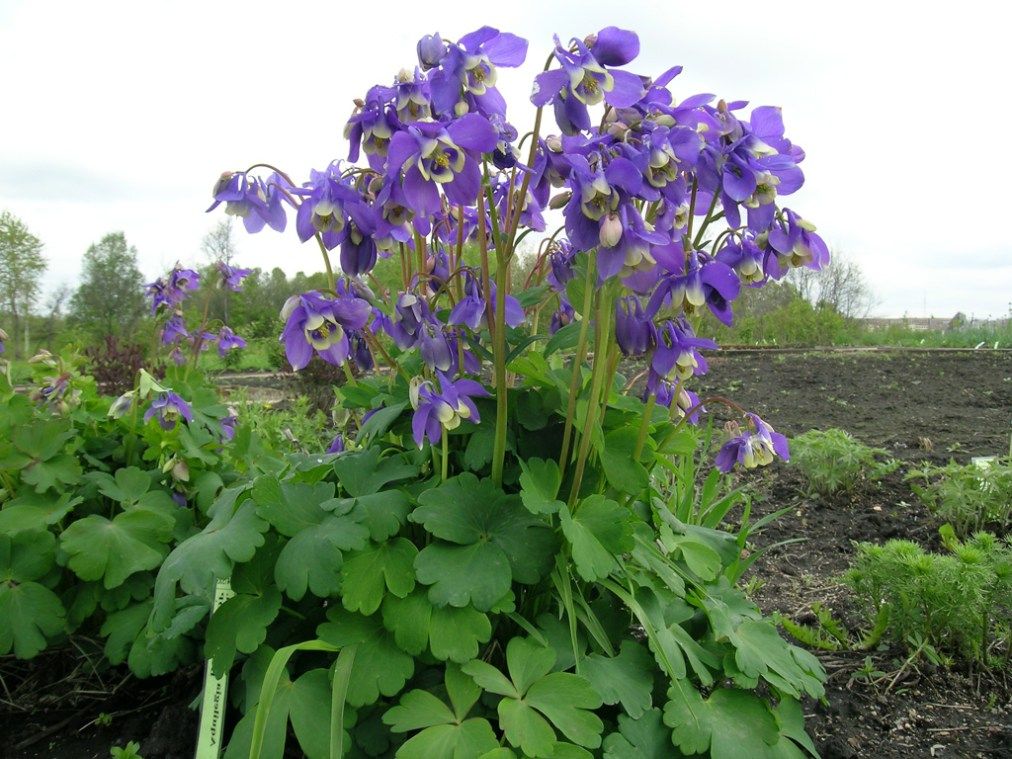
Hydrangea
- Hydrangea grows a shrub or a small tree, there are varieties that are vines. The most popular among many types of hydrangea are: blood, large -leaved, petiole, tree. Flowering time is about six months, starting from spring to the last autumn months.
- Hydrangea flowers are inflorescences in the form of balls, most often white, however, depending on the composition of the soil, the level of its acidity, some species can be painted from pale beige, however, in some species, they can be blue, red, pink And lilac.
- This plant loves heat, and some varieties during summer flowering are even characteristic of the ability to change the color of flowers. Hydrangea cannot be planted in the full shadow, since sunlight is also necessary for it - a half -prone place is suitable, with the penetration of scattered light.
- If it is supposed to arrange a hedge of hydrangea, the bushes can be originally located close to each other - then you will get a blooming natural fence. Hydrangees look good as a curb plant, as well as in combination with other green spaces. They look especially impressive at the walls of the house and on the terraces.

Delphinium
- This flower is like two in one. In the morning, he needs good lighting, in the second - it requires a shadow. Flowering occurs in June-July, and if you correctly cut the plant, then repeated flowering is possible at the end of August. A flower from the Lyutikov Dolphinium family can be either annual or perennial.
- The number of species reaches 450. These are quite high flowers (sometimes up to 2 m), with flowers with sharp spurs painted in white or shades of blue. If you do not provide the Dolphinium for a shadow for several hours a day, it can simply burn out, so it is important to select a place with a partial shadow for planting.
- On the moisturized fertile soils, neutral Or, in extreme cases, slightly acidic, Dolphiniums planted in the spring in the second year, flowering need to be thinning so that the flowers do not flicker. Keep this plant in one place for more than 10 years is not worth it to eliminate the risk of diseases.
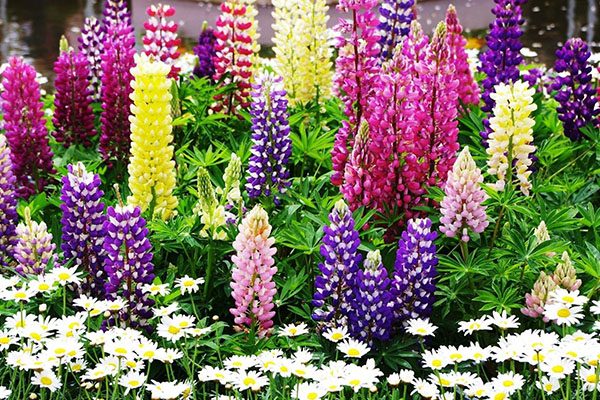
Denter
- It is mainly used as a curb of perennial, in climinals where plants are planted, whose height is about 30 cm. The flowers resemble medallions with a diameter of about 2 cm, hanging from stalks in the form of an arc, foliage-cirrus-dissected, with a bluish tint. They bloom in May-June in red-pink shades.
- It is necessary to grow them in a place protected from the wind to which young plants are very sensitive. It is a grassy annual and perennial.
- In total, about 20 species with the corresponding names are bred: the discount is magnificent, beautiful, aurora, golden flow etc. The bush can be either low, border, or reach 1 m. The germination of colors can manifest itself over 2 years. Needs drained moderately moist soil.

Iris Siberian (Kasik)
- The color scheme that is presented these flowers is unusually wide: yellow and blue, purple and pink, raspberry and brown-brown, not to mention white. Beautiful Iris and at the end of flowering: its long leaves turn beautifully in the shade.
- It is the Siberian iris that is most often grown with us, since it is hardy and practical. It requires minimal care. Iris itself is photophilous, but in the southern latitudes open sunlight are destructive for the plant, so it is better to plant them in places where the light is distracted, or are covered only at a certain time.
- The Siberian iris can withstand complete shading, this will affect the intensity of flowering, but not on the condition of the plant itself.
- Iris's mucous leaves continue to stay vertically and not crumble even at the end of flowering. The unpretentiousness of the plant manifests itself in the selection of soil, any, with the exception of aggressively acidic. Flower beds, mixborders, flower beds in the shade - everywhere these durable flowers feel comfortable.
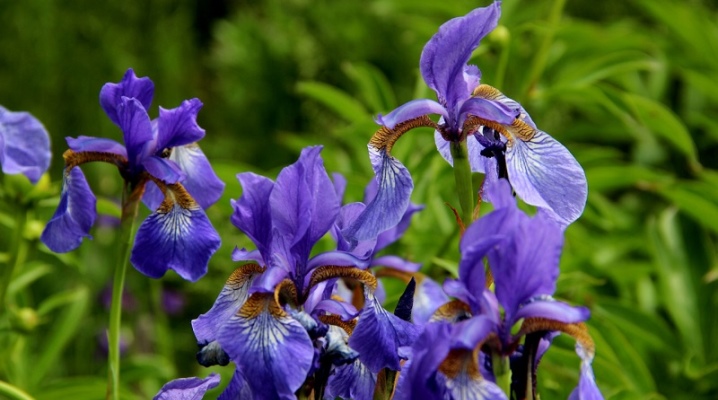
Bought
- Another unpretentious flower suitable for planting in the shade, which has large decorative leaves with dark green or colorful coloring. The flowers are similar to the flowers of the valley, most often painted in white, cream, pink, purple, greenish shades.
- They bloom in May-June, then flowers are replaced by blue-black or red berries. It is perfectly adjacent to plants such as a fern or a dicenser, perfectly decorates the garden of stones in combination with host, Lileynik, iris, geranium. It should be noted that this is a poisonous plant, and all its parts have poisoning effects.
- Perennial, located horizontally. In the spring, the escape is growing from the kidney, and in the fall the stem dies, leaving a trace that looks like a print, which became the name of another name of the plant: solomonov Print.
- The skin on shoots having a ribbed structure is usually green, and in some species - with a reddish tint. The stems are bent into half -fool, and on them in the next sequence - the leaves pointed on top with embossed veins.
- The purchased is represented by about 50 species. As a rule, it is used in the decor of shaded areas, in rockery, flower beds, looks beautiful with bravka, Ayuga, Cuff, Crocuses.

Day-lily
- Prefers a small shadow, blooms by mid -summer. The leaves are belt -shaped, and flowers are attached over their outlets with long peduncles, each of which blooms for only one day. In general, replacing a flower behind a flower, the plant pleases the eye for several weeks. Lilein is unpretentious and easy to grow. It reaches 90 cm in height, has a red-yellow gamut of shades of flowers. Refers to perennial plants. Copies with dark colors are especially suitable for shaded areas, as they quickly burn out in the open sun. Suitable for any soil, is not afraid of pests and diseases, sufficiently tolerates a small drought.
Lungwort
- Medunitsa flowers can often be found in the forest shadow. It has white spots on the leaves, and it is common to change the color from pink to blue. Separate varieties have completely green leaves, without white interspersed, and flowers of the most diverse color. The average height does not reach half a meter.
- Flowers are capable of severe smoking. They bloom in the spring, in April-May. Belong to perennials. Natural species have a corolla up to 15 mm, varietal - about 20 mm.
- The change of shades of the flower is characteristic of Medunitsa. From pink - to blue and white, there are persistent red or blue colors, flowering options with a purple or azure shade are found. Such a changing color is associated with a change in the reactions of cell juice: from acidic to alkaline as they flourish.
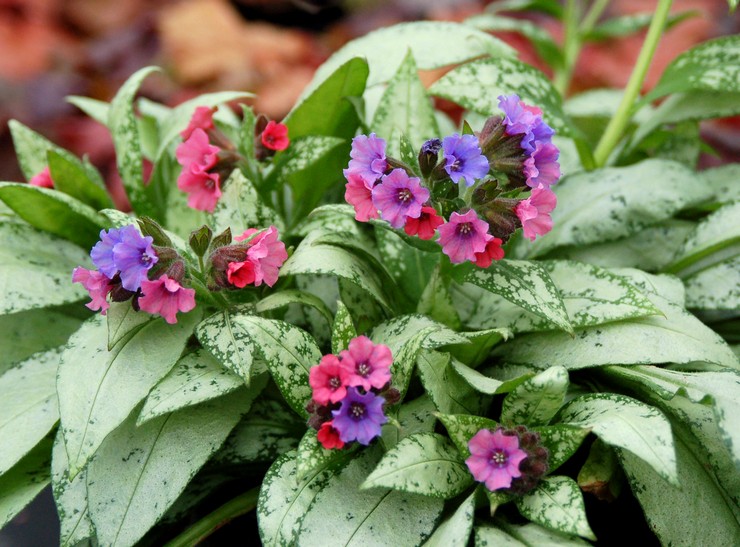
Sadovy fern
- There are many types of ferns, especially decorative ones, differing both in the color of the leaves and the shape of the bush itself, and, of course, sizes. So, for example, the height of the adyantum of the Stop -shaped is about 30 cm, and an ostrich can reach one and a half meters.
- In total, today there are about 10 thousand varieties of this plant. The types of ferns that are common in our country are usually adapted both to open areas and for growing in a shaded area.
- In general, the fern loves a shadow and needs moisture and loose soil. It can be planted where it is dark and uncomfortable for other plants. The best lighting for fern are scattered sunlight, in the complete absence of the sun, the plant can lose the saturation of green leaves (they are correctly called Vaii), but will not die.

Snowdrop
- Snowdrops belong to small -loud primroses, one of the first colors appearing in the spring (usually, depending on the climate, March-April). A low flower (up to 20-25 cm), white, with three inner petals having green tips and three external.
- A slight shade is suitable for this perennial. There are about 15 types of snowdrops in total. The name completely means the “life” of the flower: almost the entire bulb is in the ground, and the roots growing begins in the fall, in the spring turning into height and color.
- The snowdrops are undemanding to the composition of the soil and prefer partial shade: when they begin to bloom, only a few hours of sunlight are enough. They need moisture, which in natural conditions provides snow, and in the gardens in its absence - watering.
- Frost resistance of the plant is manifested by longer flowering at low temperatures. Most often, snowdrops are planted under trees and shrubs, they also look good in alpine slides or in low flower beds. They look best on their own, planted by the carpet, and the “company” can be composed by other bulbs, which will bloom later and will close the yellowing wilting leaves of the snowdrop.
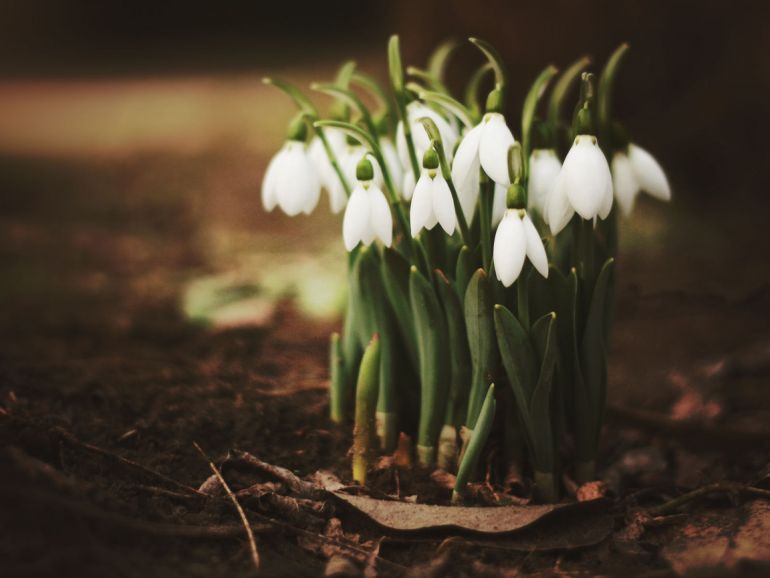
Primrose
- Primes-stunted (on average 10-20 cm) perennials that will decorate the front of the flowerbed, "hiding" from the sun with higher colors. Flowering time of most species is April-May. Unexual species are popular, with terry flowers having a variety of rims, in total there are before 550 species.
- The leaves can be simple and dissected, have a lanceolate shape, and possibly both a “sitting” and their petiole fastening. The structure of leaf plates is also possible two types: wrinkled or leathery, with greater density and due to a gray-green shade, the apparent wax. There are no leaflets on long peduncles.
- The flowers themselves can be single or grouping in inflorescences. The shape of the inflorescences depending on the variety varies: pyramidal, spherical, umbrella, tier, similar to a pillow or bells.
- The flower has a tubular shape with a bend (flat or in the form of a funnel). Coloring flowers and yawns - various shades.
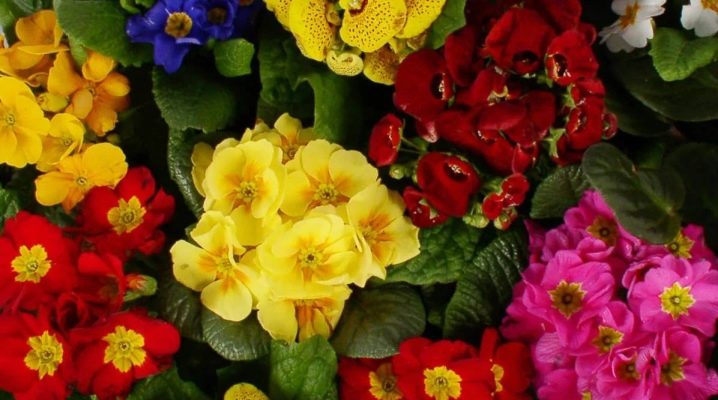
Rogersia
- This is a plant from the family stoned Something resembles a decorative rhubarb. Suitable for planting in shady borders, provided that the soil moisturizes. On long petioles, finger or cirrus leaves are attached, collected in curtains having a rich green tint.
- The flowers are complex panicles of many peduncles, most often with a white-pink color. This is a perennial plant that can reach a height of a meter to 1.8 m. Rogersia is often decorated fences and buildings in suburban areas.
- Flowering takes place in the middle of summer and lasts about a month, and then until the fall in the garden, the greens of foliage looks beautiful, replacing in September-October to red-brown tones. Suitable for landing on flower beds and mixborders, in rockers. It will be good to combine with fern, host or, for example, Podofill. It looks no less impressive in solitary planting, especially in the shade of trees or on lawns.
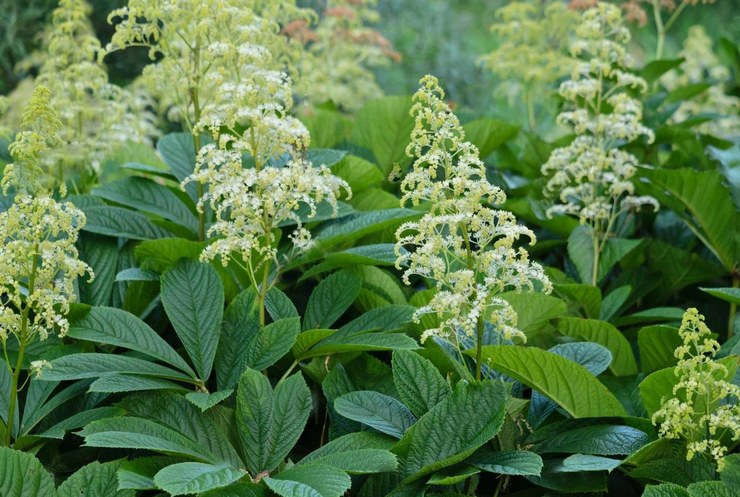
Rhododendron
- The flower feels best in partial shade, but the deep shadow for it is the problem - the rhododendron is able to continue flowering, however, much less magnificent.
- Green leaves by the fall, like the rest of the living nature, begin to turn yellow or covered with a crimson. Relating to the hearing rhododendron is most often a shrub, less often - deciduous or evergreen (semi -earned) trees.
- There is a total 1300 species Rhododendron, which are represented by both high specimens reaching 30 meters and curly, creeping on the ground. And choosing a place for planting Rhododendron, you should make sure that neither wind nor direct sunlight, i.e. To recreate the atmosphere close to the natural atmosphere, in which the plant is usually shaded, including coniferous.
- The group arrangement of rhododendrons, outlining the edges of lawns or paths, will look beautiful. At the same time, you should pay attention to the selection of species in height, from low to the edges to high - to the center. If you create a composition of several varieties of plants, then a combination with coniferous representatives will become spectacular.
- You can create beautiful decorative color schemes, choosing the color of large colors, the options of which are many: purple, orange, yellow, pink, in all the versatility of their shades, interspersed with red or green tones.
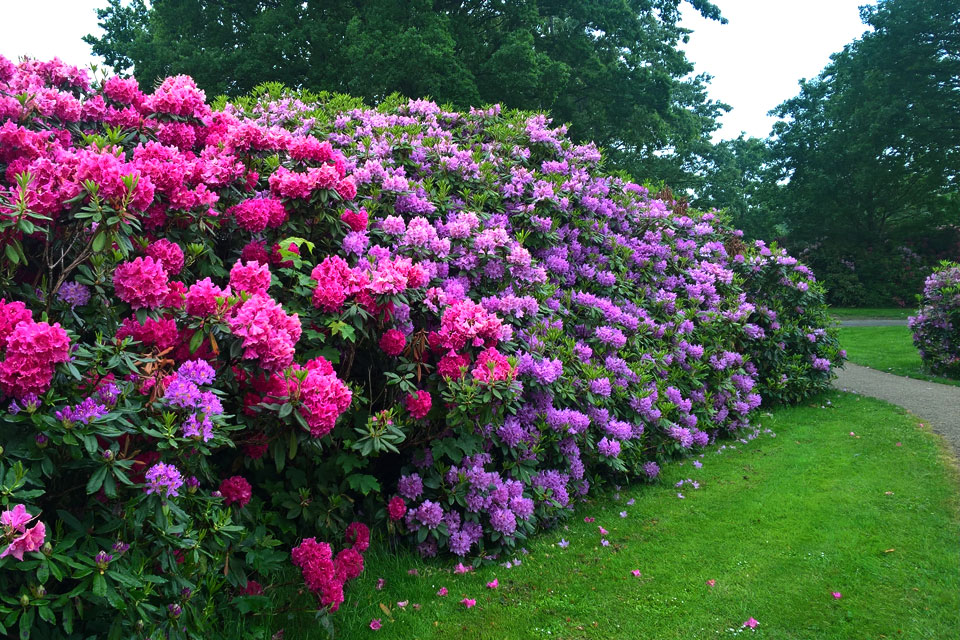
Smilacin
- This perennial is often planted as a curb. It has stems curved by an arc, on which small stalls-stalls are located in the form of brushes inflorescences, which later change to red berries. Forming a bush with a height of 60 to 90 cm, Smilacin blooms in May-June and perfectly decorates any wooded corner of the garden.
- More than 25 varieties of this unpretentious low shrub from the Landyshev family-light green oval or elongated leaves with longitudinal veins. It is quickly formed in the form of a continuous green carpet, therefore it is popular in landscape design. Good neighbors for Smilacins - grassing shrubs and plants.
- At the top of the stem - small white or purple flowers collected in a panicle. The bud has 6 petals, and after flowering, a berry is formed in place of the flower.
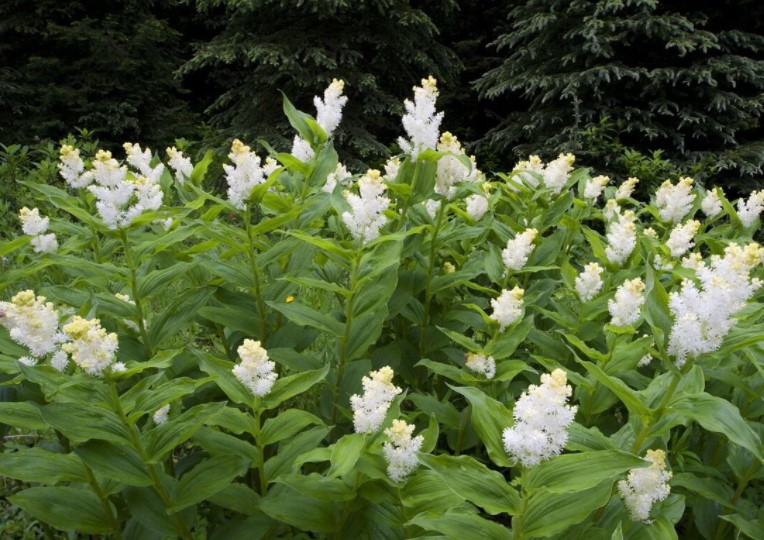
Tiarell (Tiarka)
- Tiarell is also a perennial that can bloom white-cream brushes Small fluffy flowers in different months, depending on the species: in May-June (for example, multi-leaved), or from June to September (like Verri variety).
- Their flowering is quite long, and at the height of the bush up to half a meter, they feel comfortable under the trees, because they do not like direct sun. But they need moisture and fertile soil to creep beautifully. In the outlet of the leaves of a rounded heart-shaped shape closer to the summer, a brown 10-15-cm pleasantly smelling flower appears-this is what the flowering of Tiarelli looks.
- The leaves themselves can be complex, consisting of 5 leaves. They are usually green, shaded depending on the variety either by veins of a contrasting color or a violet middle.
- Today, Tiarka is represented by many varieties that have dissected leaves and flowers painted in colors from snow-white to purple. The low evergreen tiarell from the stone -sized family is beautifully combined with heyera, Lileynik, Astilboy, Fern or HostSpeaking a beautiful decor for household buildings, the northern walls of buildings, fences, alleys and paths.
- Facilitates the care of this beautiful plant of it relative unpretentiousness, which is expressed in resistance to drought and frosts.
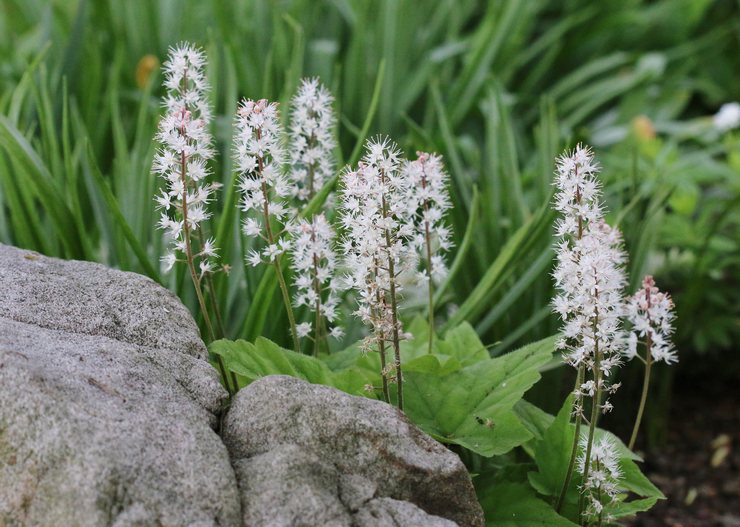
Violet
Violets - many, and the above -mentioned pansies also belong to this type.
For garden planting in the shade, long -term violets of the following varieties are usually chosen:
- Fragrant, having a white or blue color of 2 centimeter flowers, growing up to 15 cm. Color-in May.
- Horned, reaching 20 cm and blooming lilac, starting from May and ending with September.
- Labrador usually has shades of blue and purple, grows up to 10 cm and blooms at the end of spring-early summer.
- The yellow violet also reaches 10 cm, the color is May-June, and the color of the flowers is laid in the name itself.
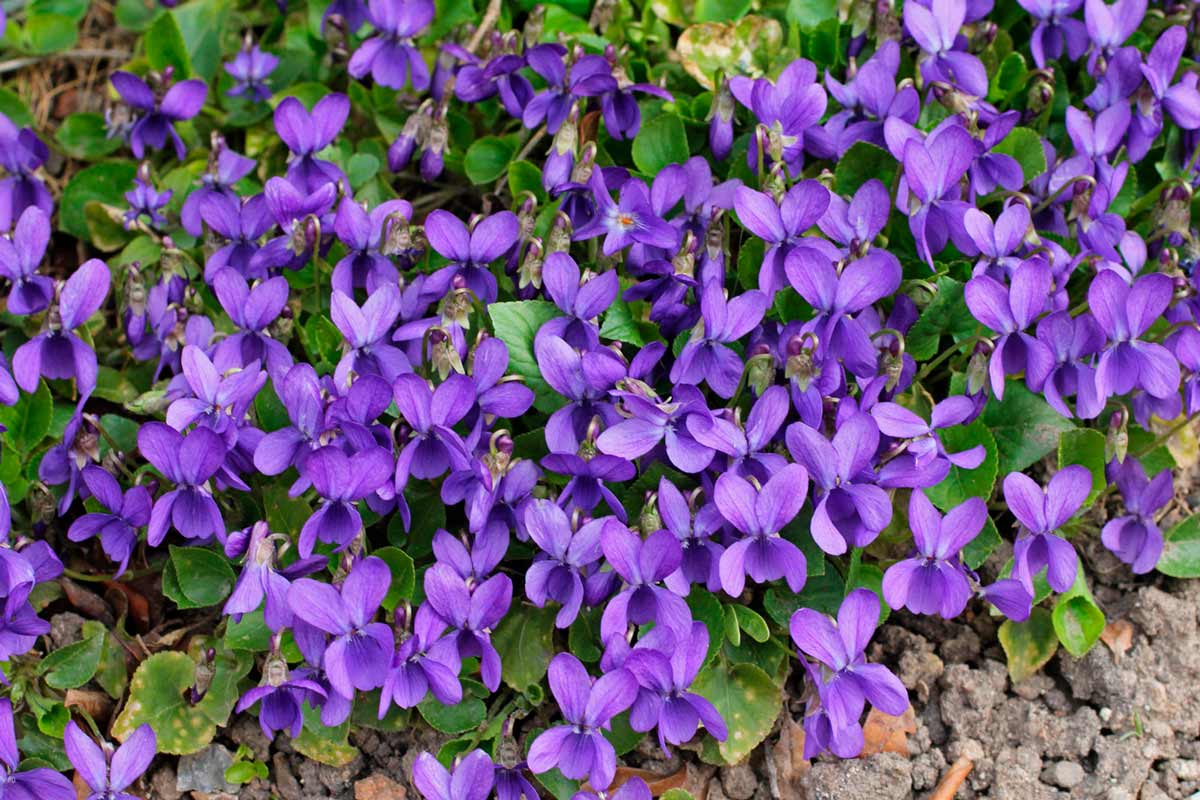
- All these colors need a shadow and watering in dry times. For better flowering, it is necessary to remove those inflorescences that have already faded. Violet leaves are usually located alternately, or grow from a basal outlet.
- In full shadow violet It can suffer from slugs, especially with high humidity, so it is better to provide it with multiple light and moderate watering.
- This flower can often be seen in the design of flower beds or borders, rocky slides or mixborders. A large number of species (over 450) are similar to their single flowers, larger lower petals with spurs. It starts to bloom in the second year after landing.
Floxes
- Floxes, like violets, can be one- and perennial, the total number of varieties- about one and a half thousand. Flowering is different: the early ones are revealed in the spring, the middle ones are in the summer, and the late bloom from summer to autumn. They prefer a small shadow. Small flowers (up to 4 cm), resembling bells, are collected in inflorescences, which can be in diameter up to 10 cm.
- The petals are pointed or rounded, slightly bent. Perennial plants are higher than annuals: the former reach 80 cm, the latter-50. Now the phloxes are bred, representing semi -cups.
- The color of the flowers is the most diverse: all shades of red, pink, salmon, lilac, yellow, blue, white. There are terry varieties.
- Often decorate with phlox alpine slides and rockers. For the shadow, the view is most suitable for the thrill. In general, all phloxes feel good in partial shade and love moderate watering.
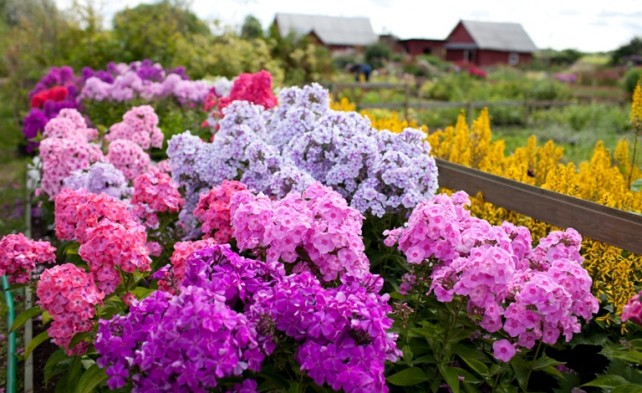
Host
- The host has a very beautiful foliage having yellowish or white longitudinal stripes, and sometimes green-blue. The size of the sheet is 5-38 cm, the shape is round or heart-shaped. Cool flowers are collected in panicemic inflorescences that delight the eyes in the summer months with white, pink or lilac.
- The host is planted as a border perennial, often under the trees, creating a partial shade to the plant, or in the shady areas of mountaineering. It grows up to 50-80 cm, separate, specially bred varieties can be both two-meter and dwarf-up to 5 cm.
- The best place for hosts is partial shade in which it will be protected from the wind. She suffers a drought and cold quite steadfastly. The plant is an excellent cover of the soil in the shade or partial shade of garden zones, as a framing of garden paths or water bodies, lawns. Well combined with plants such as hello, bought, primrose, astilbe, Medunitsa and other tremor -loving specimens.

In what shadow do flowers and plants grow better?
- Such flowers grow in the shadow in the country or in the garden: Aquilegia (water bribe), actinidia, aconite, pansies, astilbe, badan, birch bark, Brunner, Buzina (black), buzulnik, cornflower, Volzhanka, Gaulteria, Turkish cloves, geihera, geranium, bitterness, hydrangea, gravilat, nine, sores Denter, Doronikum, Twinkle, Cypress, Kalina, Kiznik, Cypress, Clematis, Clopogon, Middle Bell, hoof, Kipelnik, Buyn, Lily of the valley, Magonia, Cuff, Medunitsa, Juniper, Hasses, Load, Seely, Paporotnik, Pakhisandra, fir, Pikhta, Pikhta, Pikhta, Pichya , primrose, Rogersia, rhododendron, blue, skimmy, snow -haired, doughing, tiarc, thuja, tulip, violet, cymbalaria, host, cleaner, clean, clarity, clarity.
- In partial shade: агератум, анемона, анютины глазки, астильба, бадан, бальзамин, барвинок, бегония, белоцветник, бораго, вейник, гвоздика гренадин, гелиотроп, герань садовая, гиацинтоидес, горянка, душистый горошек, живучка, иридодиктум, каладиум, калужница, кандык, кобея, Kohlius, Middle Bell, Korol’s, Cortaderia, Crocus, Buyn, Lundish, Levka, Lobelia, Lion Zev, Mac, Margarita, Medunitsa, Melissa, Mernder, Muscari, Perenchny mint, Narcisissa, Seekhobka, Sizyahiya, Tnen, Petunia, Pion, Pion. Spring primrose, Pushkinia, Pink radio, hazel grouse, Skimmy, Scylla, Torment, violet, fuchsia, host, estron.
As can be seen from this list, there are plants that feel comfortable both in the full shadow and in partial shade. Of course, if you follow all the necessary rules for caring for them.
We will also tell:
- The value of colors in the bouquet by quantity, color and filling
- When is it better to plant flowers seedlings
- How to dilute kvassians burnt to change the color of hydrangea
- Folk signs about flowers
- How to grow ginger in a flower pot of house on a windowsill from a spine

